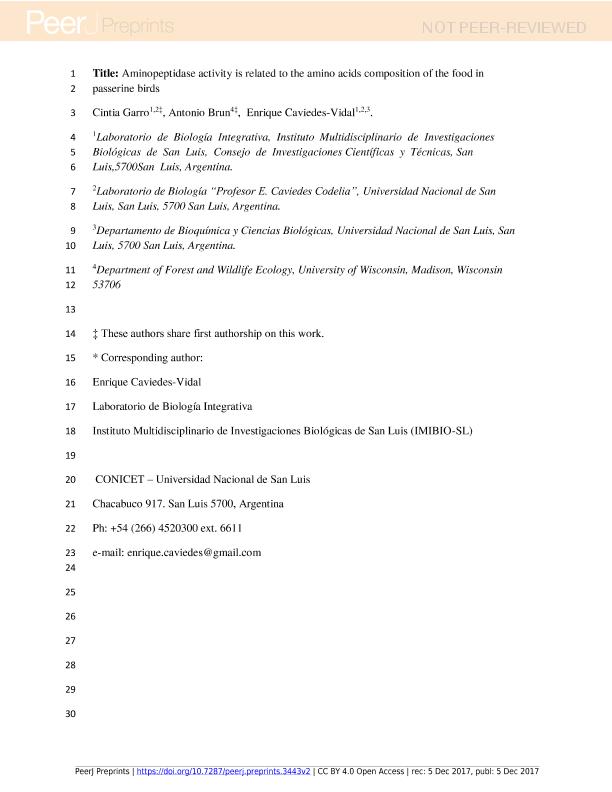Mostrar el registro sencillo del ítem
dc.contributor.author
Garro, Cintia Araceli

dc.contributor.author
Brun, Antonio

dc.contributor.author
Caviedes Vidal, Enrique Juan Raul

dc.date.available
2019-01-02T18:44:53Z
dc.date.issued
2017-12
dc.identifier.citation
Garro, Cintia Araceli; Brun, Antonio; Caviedes Vidal, Enrique Juan Raul; Aminopeptidase activity is related to the amino acids composition of the food in passerine birds; PeerJ; PeerJ Preprints; 5; 12-2017; 1-18; e3443v2
dc.identifier.issn
2167-9843
dc.identifier.uri
http://hdl.handle.net/11336/67222
dc.description.abstract
Background. Passerine birds exploit different kinds of feeding habits and they have to face seasonal changes in food availability. Therefore, the composition of the principal nutrient in their food differs from the usual. In consequence the digestive function ? enzyme hydrolysis and absorption ? have to adapt to these nutrients. These changes in digestive physiology could respond to the adaptive modulation hypothesis which postulated that the activities of digestive enzymes should match the levels of their substrates in their diet so energy is not wasted on enzymes that are no need. Thus, we decide to measure intestinal enzymes activities of two species of passerine birds that differ in natural diet. Overall we hypothesized that species with different feeding habits present enzyme activity according to the mainly component of the diet (e.g., carbohydrates, proteins). Our prediction is that the individuals will present enzyme activity proportionally to the primary components of the diets. Methods. We select for study: red ovenbirds (Furnarius rufus), which are strict insectivores and zebra finches (Taeniopygia guttata), which are specialist granivores. We complete the analysis with publish data for house sparrows (Passser domesticus) feed on high starch from the literature. To examine intestinal enzyme activities, we measured the activity of two disaccharidases (sucrase-isomaltase and maltase-glucoamilase) and one dipeptidase (aminopeptidase-N).Results. The average intestinal activity of sucrase shows that the omnivorous P. domesticus presents almost 4 times more activity than the granivorous T. guttata and more than 11 times than the insectivorous F. rufus. This difference is also reflected in the total sucrase hydrolytic capacity where P. domesticus has roughly 10 times more than the other two birds. Surprisingly in F. rufus we found maltase and aminopeptidase activity while sucrase activity was close to zero. In the case of the average activity of maltase for the omnivorous P. domesticus is approximately 40 % more than the granivorous T. guttata and more than 5 times than the insectivorous F. rufus. Although the total maltase hydrolytic capacity of P. domesticus is 5 times more than T. guttata and F. rufus. The average of aminopeptidase-N activity for F. rufus and T. guttata almost doubled the P. domesticus ones. Also F. rufus roughly doubles the other two birds in total aminopeptidase hydrolytic capacity.Discussion. This study has shown that exist a relationship between the levels of amino acids in the diet and the total aminopeptidase capacity, but in the case of carbohydrates this relationship is not evident.
dc.format
application/pdf
dc.language.iso
eng
dc.publisher
PeerJ
dc.rights
info:eu-repo/semantics/openAccess
dc.rights.uri
https://creativecommons.org/licenses/by-nc-sa/2.5/ar/
dc.subject
Aminopeptidase
dc.subject
Passerine
dc.subject
Birds
dc.subject
Amino Acids
dc.subject.classification
Otras Ciencias Biológicas

dc.subject.classification
Ciencias Biológicas

dc.subject.classification
CIENCIAS NATURALES Y EXACTAS

dc.title
Aminopeptidase activity is related to the amino acids composition of the food in passerine birds
dc.type
info:eu-repo/semantics/article
dc.type
info:ar-repo/semantics/artículo
dc.type
info:eu-repo/semantics/publishedVersion
dc.date.updated
2018-10-23T17:42:08Z
dc.journal.number
5
dc.journal.pagination
1-18; e3443v2
dc.journal.pais
Estados Unidos

dc.description.fil
Fil: Garro, Cintia Araceli. Consejo Nacional de Investigaciones Científicas y Técnicas. Centro Científico Tecnológico Conicet - San Luis. Instituto Multidisciplinario de Investigaciones Biológicas de San Luis. Universidad Nacional de San Luis. Facultad de Ciencias Físico Matemáticas y Naturales. Instituto Multidisciplinario de Investigaciones Biológicas de San Luis; Argentina
dc.description.fil
Fil: Brun, Antonio. University of Wisconsin; Estados Unidos. Consejo Nacional de Investigaciones Científicas y Técnicas; Argentina
dc.description.fil
Fil: Caviedes Vidal, Enrique Juan Raul. Consejo Nacional de Investigaciones Científicas y Técnicas. Centro Científico Tecnológico Conicet - San Luis. Instituto Multidisciplinario de Investigaciones Biológicas de San Luis. Universidad Nacional de San Luis. Facultad de Ciencias Físico Matemáticas y Naturales. Instituto Multidisciplinario de Investigaciones Biológicas de San Luis; Argentina
dc.journal.title
PeerJ Preprints
dc.relation.alternativeid
info:eu-repo/semantics/altIdentifier/doi/http://dx.doi.org/10.7287/peerj.preprints.3443v2
dc.relation.alternativeid
info:eu-repo/semantics/altIdentifier/url/https://peerj.com/preprints/3443/
Archivos asociados
